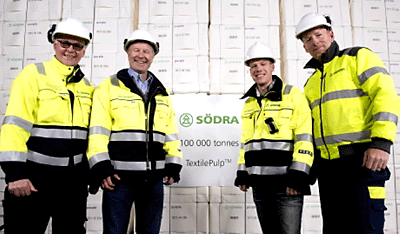 Södra Cell, Sweden, reports that it has sold 100,000 metric tons of textile pulp (dissolving pulp) since production began at its Morrum mill in December 2011. This milestone has been reached sooner than planned.
Södra Cell, Sweden, reports that it has sold 100,000 metric tons of textile pulp (dissolving pulp) since production began at its Morrum mill in December 2011. This milestone has been reached sooner than planned.
"We had budgeted to produce 50,000 metric tons in 2012. That we reached 100,000 metric tons in January 2013 is a fantastic result," said Dag Benestad, business operations manager for Södra's textile pulp.
It took 12 months to convert line 1 at Mörrum to textile pulp and the company is now looking at converting an additional line to hardwood-based textile pulp, primarily for customers in Europe and Asia.
Today, the main market for dissolving pulp is the textile industry, for example, in the manufacture of viscose. Wood fibers have been used in clothing manufacture since the 1920s. The emerging market in Asia and the increased interest in environmental issues have contributed to an upswing in the production of this type of clothing. Today, 4% - 5% of the world's textile fibers are based on cellulose from wood, corresponding to approximately 4 million metric tons of pulp. The pulp can also be used in the manufacture of cellophane, Wettex cloths, hygiene articles, etc.
The dissolving pulp produced by Södra is called textile pulp since it will be sold further to customers who will dissolve the pulp and produce viscose pulp. In the next phase, yarn will be spun, which will then be used in clothing production.
Södra Cell is the world's third largest market pulp supplier, with a total annual production of more than two million metric tons. In December 2010, the company made an investment to begin producing textile pulp at Mörrum. At full capacity, 170,000 metric tpy of hardwood textile pulp is currently being produced. Production started at the end of 2011.
TAPPI
http://www.tappi.org/